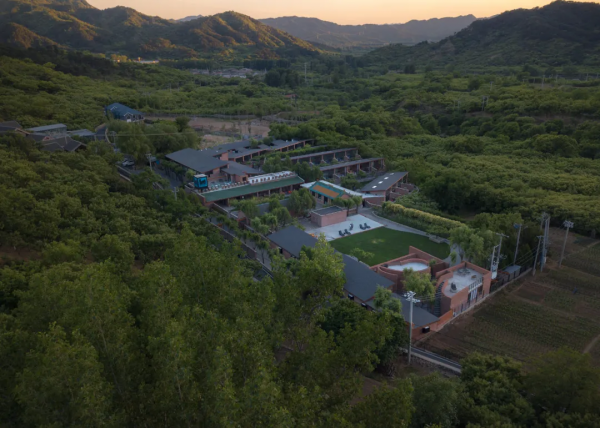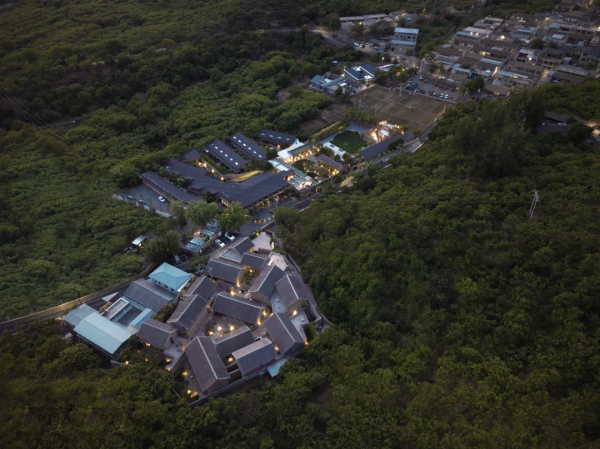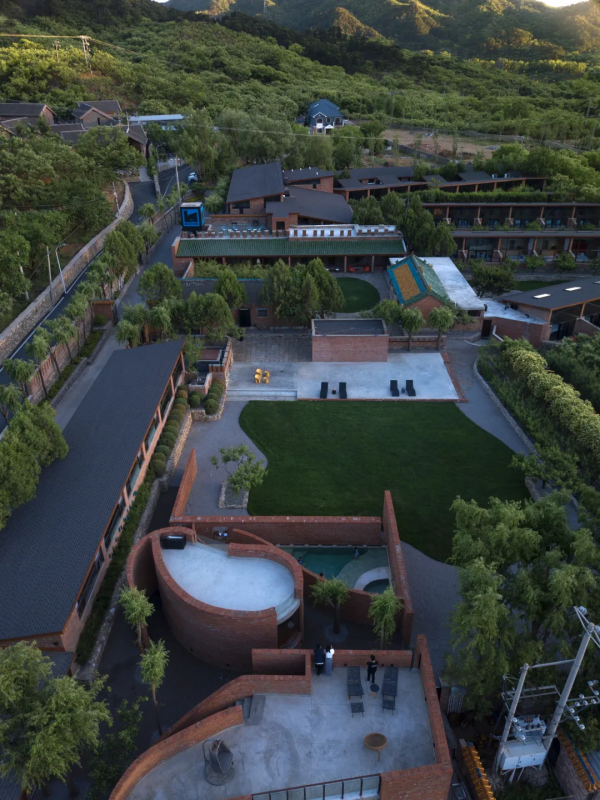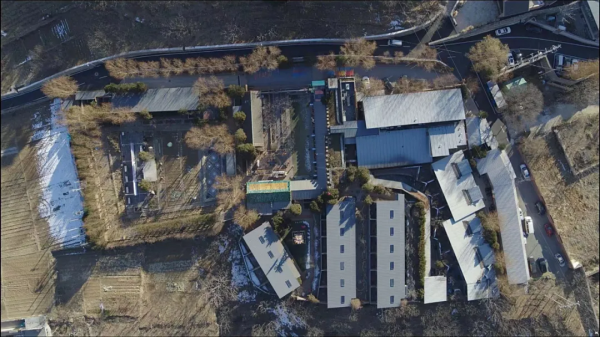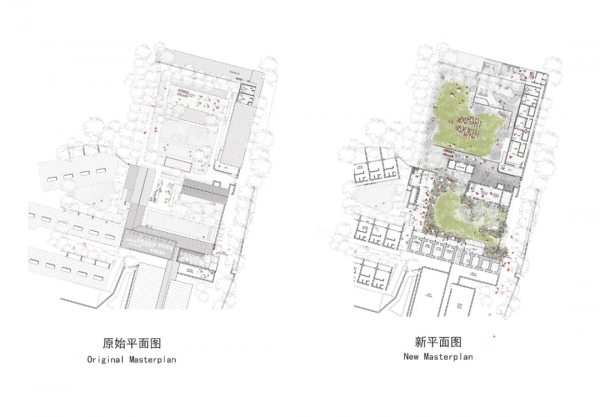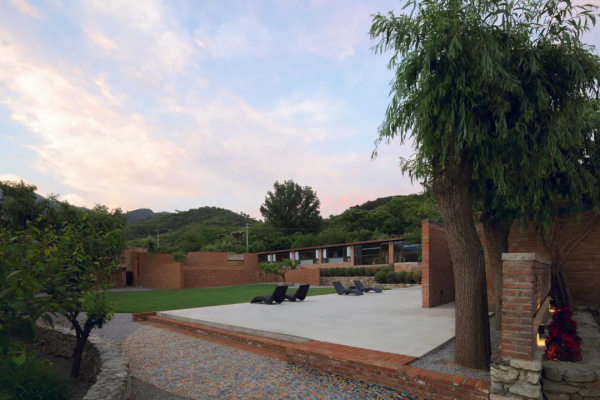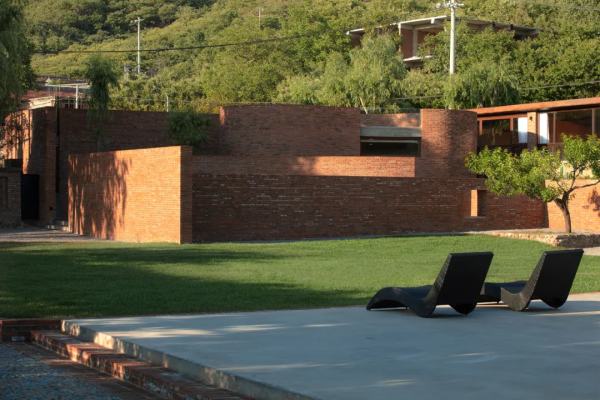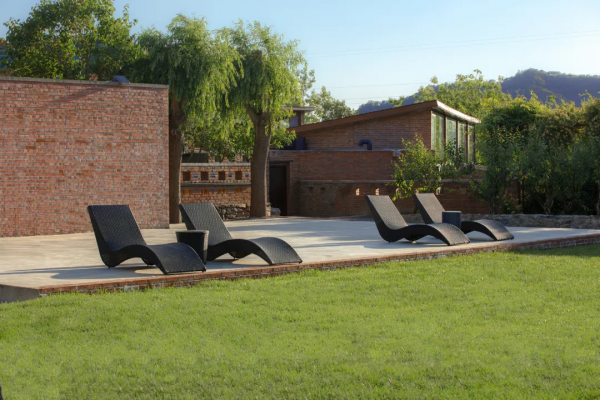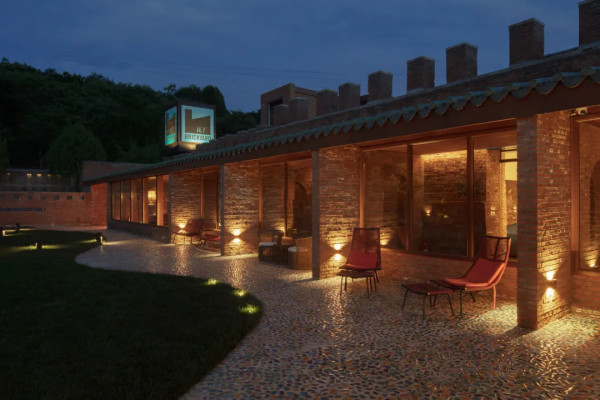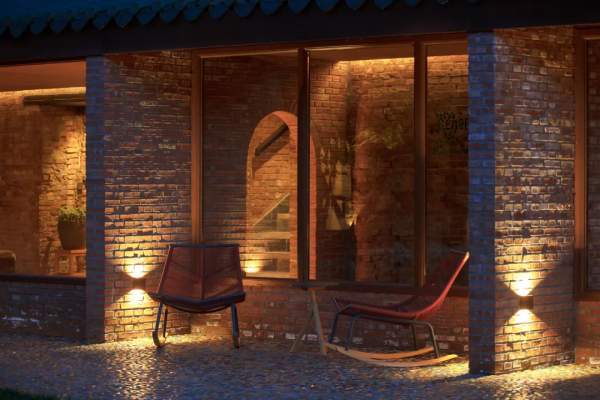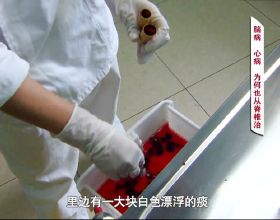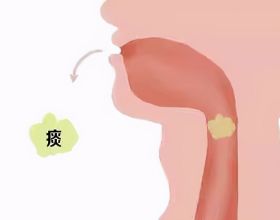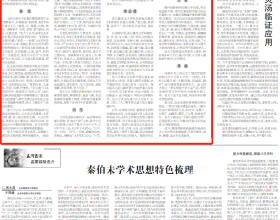瓦廠酒店頂視 The Brickyard Retreat top view 存在建築
感謝 llLab.敘向建築 分享
瓦廠酒店背景介紹
Brief Background of the Brickyard Retreat
位於北京市懷柔區北溝村慕田峪長城腳下的琉璃瓦廠原為北溝村自營的燒製作坊,然而隨著市場不景氣的因素而廢棄。而後,廢棄的瓦廠建築被住在附近的熱愛建築學及中國文化的國外村民改建成為瓦廠酒店。
The history of the Brickyard Retreat can be traced back to an independent tile firing workshop, known as the glazed tile factory. Located at the foot of the Great Wall at Mutianyu, Beigou village, Huairou District, Beijing, the glazed tile factory had been decommissioned due to a reduction in market demand. The vacant tile factory building took on a new life in 2010 as a tile factory Hotel; the building was renamed, "The Brickyard Retreat". Owned by local villagers that love architecture and Chinese culture, the factory building took on a hospitality role under their care.
2020年9月1日起,毗鄰瓦廠的三卅精品民宿的業主併購瓦廠酒店,llLab.敘向建築設計則有幸再次參與其中,以共同打造北溝村的鄉村建設及文化發展的下一步。
On September 1, 2020, the building transitioned again. The owner of the nearby "San Sa Village" acquired "The Brickyard Retreat" and llLab. was honored to be invited to participate in the next step of cultural development for the Beigou village.
區域性頂視 Part top view 存在建築
北溝村的生活文化結構
The Structure of Cultural Life in Beigou Village
北溝村因其地理位置鄰近慕田峪長城而聞名,2018年,位於北溝村的瓦廠酒店又成為首批由中國國家文物局和中國古遺址保護協會共同評選的中國鄉村遺產酒店。至今也是北京唯一一家獲此殊榮的遺產酒店。
Beigou village is famous for its geographic feature and proximity to the Great Wall of Mutianyu. In 2018, "The Brickyard Retreat" in Beigou village became one of the first Chinese rural heritage hotels jointly selected by the State Administration of cultural relics of China and the China Association for the protection of ancient sites. So far, it is still the only Heritage Hotel in Beijing to receive this award.
酒店整體鳥瞰 Aerial view of the Brickyard Retreat 存在建築
100多戶村民因旅遊行業及近期興起的農家樂,而各自發掘並運營著不同型別的民宿事業機會。同時,因為三卅的建成,北溝村也逐漸形成了自身的運轉體系,為遊客帶來了不同型別的旅行住宿體驗,為村民帶來了各種不同的工作機會,並同時發掘出潛力的發展需求,使鄉村振興與城市空間的探索結合形成了更新更可持續的生態組成結構。
A renewed interest in cultural tourism has prompted more than 100 villagers of Beigou Village to create and operate different types of B & B business opportunities. At the same time, with the completion of "San Sa Village", Beigou village has gradually formed its own tourist infrastructure, which has brought a great variety of travel accommodation experiences for tourists. This hospitality development has generated multiple job opportunities for local villagers and continuous to support social development for the community. The combination of rural revitalization and cultural preservation presents a promising strategy for a sustainable and ecologically informed development.
北溝村 Beigou Village 存在建築
區域性鳥瞰 Partial aerial view 存在建築
瓦廠改建的目標與策略
Target and Strategy of the Brickyard Retreat Renovation
在這樣的新社會框架及生活需求條件下,瓦廠的演化及更新也就成為了它及其擁有的文化遺產繼續衍生及傳播的必經過程。
The Brickyard Retreat is an example of a new trajectory of urban renewal in this region. A trajectory of carefully considered architectural interventions that are necessary and unavoidable in order to protect and support a thriving cultural heritage.
改造前,圖源網路 Before reconstruction
改造前後平面圖對比 Comparison of plan before and after reconstruction llLab.敘向建築
改造前後範圍 Scope before and after reconstruction llLab.敘向建築設計
瓦廠的改建,主要集中體現在整體區域的整合劃分,以及三個主要元素上——琉璃瓦、舊址窯洞、磚,分別體現了文化的遺產,建築的歷史,及本地的文化。同時用最純粹的體現手法,使建築空間,景觀空間,與大自然的連結關係在不同的比例關係下產生呼應及相互的層次襯托。
The architectural intervention in The Brickyard Retreat is structured around three main architectural elements: Glazed Tile, Old Kiln and Red Brick. These elements are of particular significance as they reflect the cultural heritage of the factory, the architectural history of the space and the local culture of the village itself. The intervention leverages these elements to articulate program spaces, landscape features and a mutual respect to the site.
建造過程 Construction process llLab.敘向建築
空間框架
Spatial Framework
整體區域來理解,主樓,原燒瓦窯洞區域所在的南院一側,是以接待、會議、活動等集體體量的,更活躍一些的氛圍為主的院落。
The program is organized around the main building on the south side of the courtyard; this is the space where the original tile burning kiln is located. The building's program includes a multi-purpose reception space that can also accommodate small gathering events.
平面圖 Site plan llLab.敘向建築
模型圖 Model llLab.敘向建築
在平衡建築莊嚴及歷史厚重感的同時,用自然及明亮的多色彩為表現方式,使其能在過去的莊嚴感中尋找能夠啟用和愉悅的空間體驗方式,使內容及氛圍在這種活化的設計手法中能夠帶著過去和歷史的背景,一同演變。
Embracing the architectural and historical importance of its features, tiles in both natural and bright colored glazes are used throughout the floor. Forming an organic mosaic, the combination of historical features and contemporary design interventions provides and stimulating atmosphere that connects its new use with its previous technical background and creative history.
院落內部 Inside the courtyard 存在建築
繞過院落連線的屏風處,抵達北院,則視野豁然開朗,材料清晰區分,使本地,鄉村,康養生活的自然感受最大化,使活動方式也緩慢下來,形成對比強烈的一種慢速恬靜的意境,使生活體驗及自然感受成為北院空間的最主要載體。
The north courtyard, offers a distinctly different vision. The use of local red brick and the open view of the Mutianyu Great Wall reinforce a natural connection to the local, rural and traditional lifestyles. This is a quiet space that aims to slow down activity patterns, offering a space for rest and creativity. The north courtyard space focuses on the perception of nature and landscape.
模型圖 Model llLab.敘向建築
存在建築
設計元素 - 琉璃瓦、舊址窯洞、紅磚.
Design Elements - Glazed Tile, Old Kiln, Red Brick
整體設計遵循尊重天然材料的表現形式標準,以材料自身的屬性,在自然條件下的變化,來凸顯人與自然與時間之間的關係。
The design intent seeks to honor the authentic quality of natural materials and highlights the relationship between human beings and nature over time. This is a direct reference to the dialectical relation between craftsmen and their understanding of the natural properties of materials.
剖面圖 Section llLab.敘向建築
模型圖 Model llLab.敘向建築
瓦廠坐落於北溝村,北溝村則本以自身建築的材料風格及做工手法為一種自信的象徵代表。同時瓦廠改造,則以尊重琉璃瓦廠的文化為基礎,突出文化產物能給人與社會帶來的一種意識變化。因此,主要設計元素即以表現這些本地的文化元素,歷史沉澱及重新啟用文化底蘊的手法來實施。
"The Brickyard Retreat" demonstrates pride in the Beigou village heritage by honouring a tradition of exceptional workmanship while defining its own architectural style. The renovation of "The Brickyard Retreat" respects and embraces the local craft history while highlighting the evolution of consciousness that cultural products can bring to people and society.
整體鳥瞰 Overall aerial view 存在建築
琉璃瓦
Glazed Tile
舊址窯洞建築語言整理統一化,並在屋頂、室內鋪地及室外庭院的鋪地等不同空間層面採用不同比例,不同尺度,不同方法的應用,使此文化遺產元素能夠透過不同的感官、視覺、觸覺的聯絡,與人進行溝通,以傳遞對於此文化遺產在現今社會的重新理解及演變意義。
The architectural language of the kiln, a sequence of cave-like space, is unified and intensified through the tiling treatment in the floor. Different sizes of tiles and methods of tiling support the distinct atmospheres of each space. The roof, indoor paving and outdoor courtyard paving have each their own distinct tiling pattern. The glazed tile mediates the cultural heritage and history of the building. The rich tile mosaics engage the visitor through multiples senses, from its varied tactile quality, its acoustic signature, to its visually engaging brightly colored patterns. Every effort is made to convey the social significance of preserving and reinterpreting cultural heritage in the current society.
夜晚的院落 Courtyard at night 存在建築
統一的綠色琉璃瓦屋面整體形成一條直線,在強調老窯洞建築的歷史意義的同時,與原有的花色琉璃瓦建築在屋頂的層面平衡。同時綠色的屋頂在地面層人眼視角上,將屋頂與自然的草地植被面聯絡,使感受者能夠自身將空間的不同層面結合起來。
當感受者能夠將自身放置在這樣的角度時,主要體驗就已經和其中一層面的琉璃瓦處理融合了,也就是將不同的舊瓦及新瓦透過手工敲制而形成的碎片,作為畫面路面的鋪裝。進入室內時,鋪裝的比例變化為更加精細的尺度,使感受一層層的遞進。
The green glazed tile roof forms a straight datum line, this gesture acts as a canvas for the more organic forms of the kiln structures. The bright green of the tiles marks the importance of the building, referencing the hierarchy of roof color in traditional architecture, while echoing the vibrant greenery of the natural vegetation around the site.
綠色琉璃瓦屋面 The green glazed tile roof 存在建築
存在建築
存在建築
llLab.敘向建築
舊址窯洞
Old Kiln
舊址窯洞是瓦廠本身最具有歷史的一部分,所以在保留內部窯洞空間肌理的同時,增加了更加親人的室內牆體面,使感受者能夠靜止並各角度的感受窯洞內的空間。
The former kiln is the most historical part of the tile factory itself. To celebrate its unique quality, the existing interior texture of the structure has been preserved as much as possible. Only one extra interior wall has been added for both safety and comfort reasons. With this minimal intervention, the guests can experience the space in the cave from all angles while having the opportunities to access the unique multi-layered material deposits - relics of its former use.
存在建築
窯洞細節 Kiln details llLab.敘向建築
此外,延續窯洞建築的拱門特點,將拱形門廊,延伸到建築的主入口,使加深窯洞歷史的沉澱感,建築的體量莊嚴感,同時儘可能保留窯洞原有的空間感受,並將最核心的歷史意義直接作為第一印象傳遞給感受者。
The arched porch has been extended to become the main entrance of the building, this provides the visitors with a first impression, appealing directly to the heritage of the building. This gesture enhances the historical importance of the kiln building and reinforces the solemn nature of architectural language.
拱形門廊 Arched porch 存在建築
紅磚
Red Brick
紅磚建築的延續則更是作為本地鄉村肌理的延續,並在空間內容上嘗試突破到新的生活層面。
鄉村傳統意義理解上的材料與建設手法,嘗試在建設過程中就做出一定挑戰,以形成不一樣的空間架構,從而給未曾實現的空間體驗能夠在相同材料但不同空間內實現。這種用傳統模式呈現不傳統生活體驗的傳統模式演變進化,則希望給城市與鄉村在生活空間理解和意識形態上,進一步的進行融合與探索。
Materials and construction techniques, within the traditional sense of rural construction, have been challenged in the project. The re-appropriation of these methods provides new expressive qualities to the materials when they are used in a different architectural framework. While red brick is extensively used, in homage to the local rural heritage, it is used with more autonomy than before in order to break through and reach a new level local expression.
The re-conceptualization and re-appropriation of traditional materials and techniques seeks to investigate the dialog between spatial relations, forms of inhabitation and ideologies from both urban and rural life conditions.
存在建築
存在建築
存在建築
存在建築
期望及遠景
Expectation and Vision
瓦廠改造是我們在慕田峪長城腳下的北溝村,自叄舍鄉情驛站、三卅之後,又一個對於鄉村生活文化背景的研究與空間擴充套件,同時,也是又一個層面的對於鄉村及城市生活關係的探索。
Three years after the completion of "San She Nostalgic Station" and "San Sa Village", at the foot of the Mutianyu Great Wall, The Brickyard Retreat presents itself as another study of spatial and cultural reappropriation within this unique rural context. The project challenges the relations between rural and urban life within spaces of critical cultural significance.
存在建築
我們希望用一種包容的、迎接的態度,用當地的人文模式,去描繪它自身的莊嚴意義。在這樣的條件下,運用景觀和建築語言,創造相互關聯的空間品質,激發人們積極尋求對文化的特殊感知。
At llLab. we seek to develop an inclusive approach, that reconceptualize local landscape and architectural languages to create interrelated spatial qualities. We hope that the projects can stimulate people to actively seek a special perception of culture.
存在建築
專案資訊
專案名稱:瓦廠改造專案
專案位置:北京市懷柔區北溝村瓦廠
專案場地面積:5336.27㎡
新建築面積:393.54㎡
改造建築面積:752.36㎡
專案總建築面積:1145.9㎡
專案時間週期:2020年9月3日 – 2021年5月1日
專案客戶方:貳零四玖投資集團有限公司
專案階段:已建
專案設計團隊:llLab.敘向建築設計
專案合夥人:Luis Ricardo、劉涵曉
專案團隊:劉凌靈、嚴予雋、陳霏、趙懿慧、Henry D'Ath、Matt Eshleman、尹凌空、魏子煜、Camilo Espitia、朱安琪、俞婕
專案結構顧問:欒櫨構造設計事務所
專案土建:許文傑、王義等
專案裝修:北京聖和利
建築攝影:存在建築
Project information
Project name: Brickyard Retreat Renovation
Project Location: The Brickyard Retreat, Beigou Village, Huairou, Beijing, China
Site Area: 5336.27 ㎡
New Construction Area: 393.54 ㎡
Renovation Area: 752.36 ㎡
Total Construction Area: 1145.9 ㎡
Project Timeline: September 3, 2020 – May 1, 2021
Project Client: 2049 Investment Group
Project Status: Completed
Project Architectural Design: llLab. (www.lllab.net)
Project Partners: Luis Ricardo, Hanxiao Liu
Project Team: Lingling Liu, Yujun Yan, Fei Chen, Yihui Zhao, Henry D'Ath, Matt Eshleman, Lingkong Yin, Ziyu Wei, Camilo Espitia, Anqi Zhu, Jie Yu
Structural Consulting: LaLu Structural Consulting
Project Construction: Wenjie Xu, Yi Wang and their team
Project Interior Finishing: Beijing Sheng He Li
Architectural Photography: Arch-Exist Photography



